 This mammoth and category-defying opus is easily the most wildly ambitious debut in recent memory (if not ever) and also happens to be one of my absolute favorite albums of 2022. It was one hell of an enigma at first as well, as Stroom quietly released the album back in October with absolutely no background information provided at all. Given the absolutely bananas volume of material (4 ½ hours) and the consistently high level of quality, I expected that it would be revealed to be some sort of decade-spanning art project involving an all-star cast of sound art luminaries, but I turned out to be spectacularly wrong about most of that. As it turns out, Voice Actor is instead a recent collaboration between Noa Kurzweil (Supertalented) and Levi Lanser (Ludittes), neither of whom I had previously encountered. However, I was at least partially right about the “art project” bit, as Sent From My Telephone collects three years of pieces that the duo originally intended as a radio play (and there are plenty of guest collaborators involved as well). The heart of the project, however, is Kurzweil’s seductive voice and her enigmatic diaristic monologues, which makes Félicia Atkinson a close kindred spirit, yet Lanser’s varied and phantasmagoric backdrops elevate the project into a mesmerizing durational mindfuck that effortlessly blurs the lines between spoken word, plunderphonics, ambient drone, outsider R&B, psychedelia, and Hype Williams’ hypnagogic sound collage side.
This mammoth and category-defying opus is easily the most wildly ambitious debut in recent memory (if not ever) and also happens to be one of my absolute favorite albums of 2022. It was one hell of an enigma at first as well, as Stroom quietly released the album back in October with absolutely no background information provided at all. Given the absolutely bananas volume of material (4 ½ hours) and the consistently high level of quality, I expected that it would be revealed to be some sort of decade-spanning art project involving an all-star cast of sound art luminaries, but I turned out to be spectacularly wrong about most of that. As it turns out, Voice Actor is instead a recent collaboration between Noa Kurzweil (Supertalented) and Levi Lanser (Ludittes), neither of whom I had previously encountered. However, I was at least partially right about the “art project” bit, as Sent From My Telephone collects three years of pieces that the duo originally intended as a radio play (and there are plenty of guest collaborators involved as well). The heart of the project, however, is Kurzweil’s seductive voice and her enigmatic diaristic monologues, which makes Félicia Atkinson a close kindred spirit, yet Lanser’s varied and phantasmagoric backdrops elevate the project into a mesmerizing durational mindfuck that effortlessly blurs the lines between spoken word, plunderphonics, ambient drone, outsider R&B, psychedelia, and Hype Williams’ hypnagogic sound collage side.
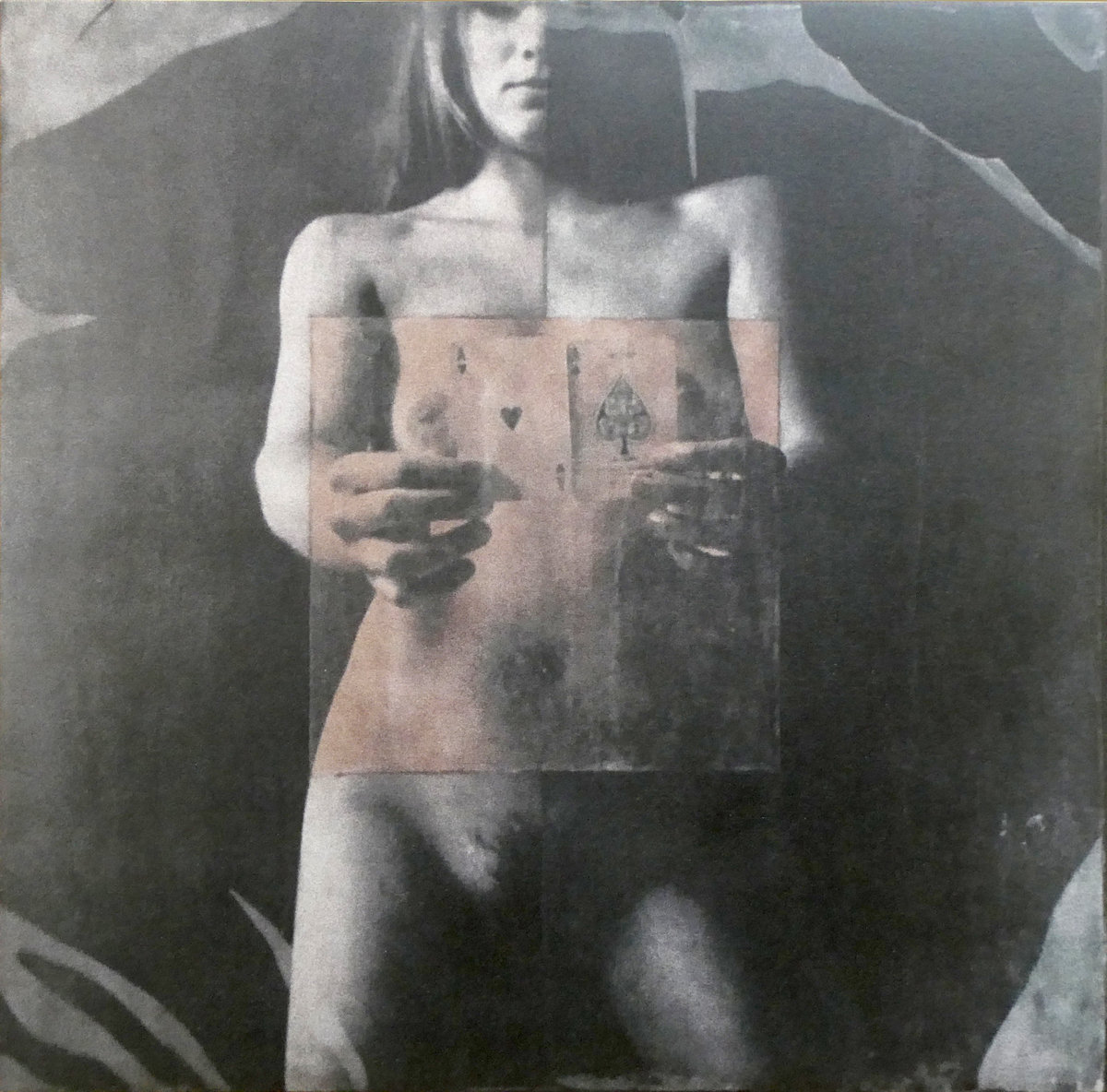 The French Standard In-Fi label has been one of my casual obsessions over the last few years and this second album from Omertà was my favorite release that surfaced from that milieu in 2022. From what I can tell as an outsider, there appears to be a loosely knit family of artists, psych enthusiasts, and avant-folk weirdos that convene periodically in varying configurations and occasionally an album will eventually surface documenting whatever magic transpired. Omertà unsurprisingly shares key members with other fitfully killer projects like France and Tanz Mein Herz, but this ensemble is an unique animal for a number of reasons. The most striking of those reasons are the breathy, sensuous vocals of Florence Giroud, who I believe is only active in this one project (as far as rock bands are concerned, at least). Giroud’s vocals aside, Omertà is also far more informed by eroticism, dream states, pop music, and chansons than the usual Standard In-Fi fare. To my ears, something compelling almost always seems to happen whenever Jeremie Sauvage & Mathieu Tilly assemble a group of like-minded artists, but Collection Particulière’s “Amour Fou” and “Moments in Love” are easily among the most beautifully distilled and haunting pieces that the label has released to date.
The French Standard In-Fi label has been one of my casual obsessions over the last few years and this second album from Omertà was my favorite release that surfaced from that milieu in 2022. From what I can tell as an outsider, there appears to be a loosely knit family of artists, psych enthusiasts, and avant-folk weirdos that convene periodically in varying configurations and occasionally an album will eventually surface documenting whatever magic transpired. Omertà unsurprisingly shares key members with other fitfully killer projects like France and Tanz Mein Herz, but this ensemble is an unique animal for a number of reasons. The most striking of those reasons are the breathy, sensuous vocals of Florence Giroud, who I believe is only active in this one project (as far as rock bands are concerned, at least). Giroud’s vocals aside, Omertà is also far more informed by eroticism, dream states, pop music, and chansons than the usual Standard In-Fi fare. To my ears, something compelling almost always seems to happen whenever Jeremie Sauvage & Mathieu Tilly assemble a group of like-minded artists, but Collection Particulière’s “Amour Fou” and “Moments in Love” are easily among the most beautifully distilled and haunting pieces that the label has released to date.
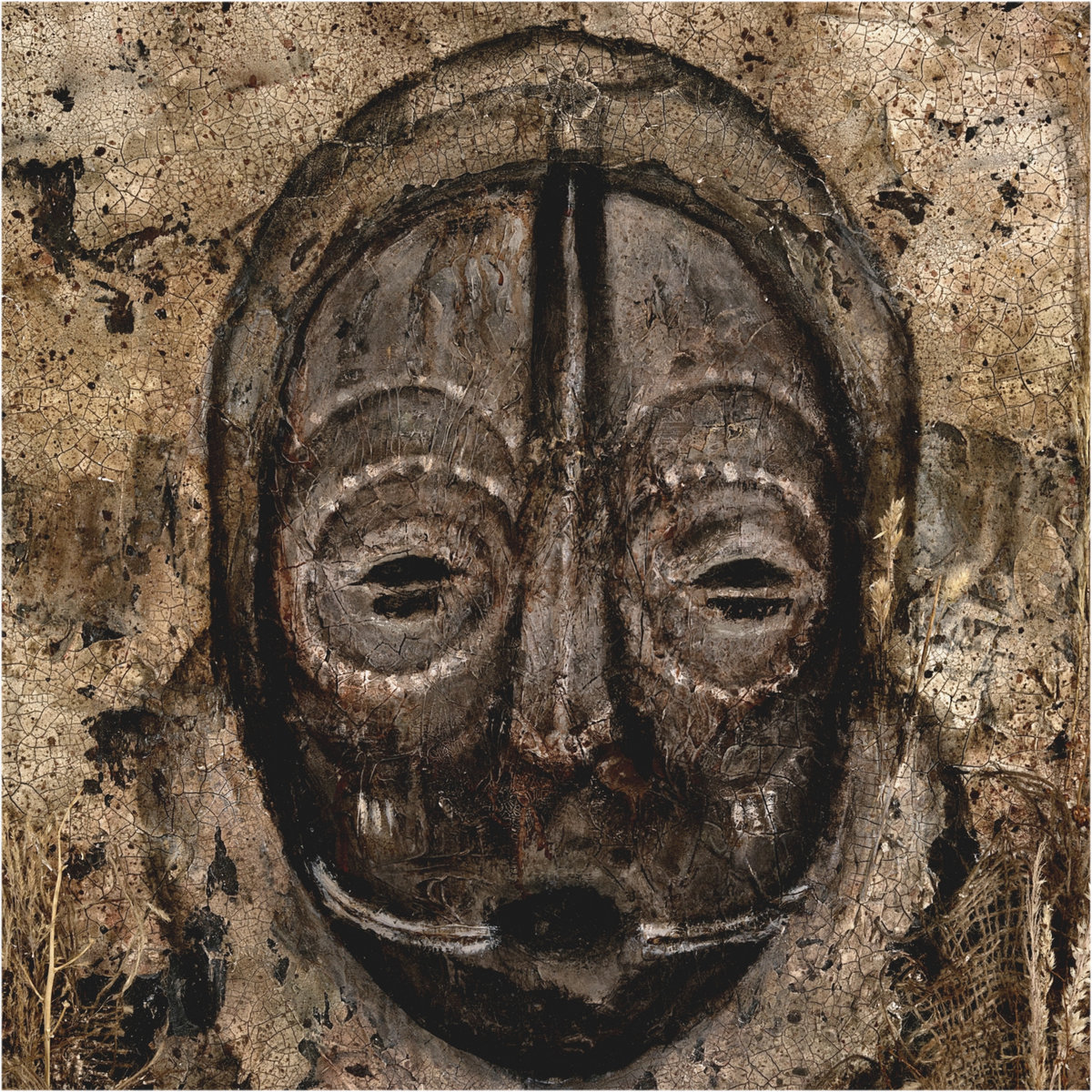 The latest from this shapeshifting and anonymous southwestern psych duo marks both their return to Akuphone and the first proper follow up to 2020's landmark The Totemist. To some degree, Ak'Chamel revisit roughly the same distinctive stylistic terrain as their last LP, approximating some kind of otherworldly and psychotropic collision of Sun City Girls and Sublime Frequencies. That said, Ak'Chamel do sound a hell of a lot more like a mariachi band soundtracking a jungle puppet nightmare this time around and that festively macabre vibe suits them quite nicely. The band might see things a little differently themselves, as this album is billed as "a perfect soundtrack for the desertification of our world," but experiencing this lysergic Cannibal Holocaust-esque mindfuck is probably just the thing for helping someone appreciate the wide-open spaces and solitude of desert life. In keeping with that desert theme, there are plenty of prominent Middle Eastern melodies and instruments on the album, but Ak'Chamel is singularly adept at dissolving regional boundaries (and possibly dimensional ones as well) in their quest for deep, exotic, and oft-uncategorizable psychedelia.
The latest from this shapeshifting and anonymous southwestern psych duo marks both their return to Akuphone and the first proper follow up to 2020's landmark The Totemist. To some degree, Ak'Chamel revisit roughly the same distinctive stylistic terrain as their last LP, approximating some kind of otherworldly and psychotropic collision of Sun City Girls and Sublime Frequencies. That said, Ak'Chamel do sound a hell of a lot more like a mariachi band soundtracking a jungle puppet nightmare this time around and that festively macabre vibe suits them quite nicely. The band might see things a little differently themselves, as this album is billed as "a perfect soundtrack for the desertification of our world," but experiencing this lysergic Cannibal Holocaust-esque mindfuck is probably just the thing for helping someone appreciate the wide-open spaces and solitude of desert life. In keeping with that desert theme, there are plenty of prominent Middle Eastern melodies and instruments on the album, but Ak'Chamel is singularly adept at dissolving regional boundaries (and possibly dimensional ones as well) in their quest for deep, exotic, and oft-uncategorizable psychedelia.
The album opens in deceptively straightforward fashion, as the first minute of "The Great Saharan-Chihuahuan Assimilation" starts with a minor key Spanish guitar and hand percussion vamp. However, subtle signs of unreality gradually creep in (such as the eerie whistle of throat-singing) before the piece blossoms into a spacious and melodic interlude of Tex-Mex-style surf twang. The following "Clean Coal is a Porous Condom" is similarly musical (if unfamiliar), as Ak'Chamel sound like some kind of outernational supergroup trading Latin, Indian, and surf-inspired licks over a pleasantly lurching "locked groove"-style vamp. Both pieces are quite likable, but the album does not start to wade into the psychedelic deep end until the third piece (the colorfully titled "Amazonian Tribes Mimicking The Sound of Chainsaws With Their Mouths"). Unusually, it is a jaunty yet bittersweet accordion-driven piece at its heart, but the central motif is beautifully enhanced by layers of vivid psychotropic sounds (flutes, voices, ululating, eerie whines, pipe melodies), resulting in something that feels like a festive collision between The Wicker Man and a haunted street fair at the edge of the Amazon.
 This latest album from Carla dal Forno is her first since relocating to a small town (Castlemaine) in her native Australia and that dramatic change in environment has understandably made quite an impact on her overall vibe (as the album description puts it, she "returns self-assured and firmly settled within the dense eucalypt bushlands"). Fortunately, it seems like the transformation was an entirely favorable one, as literally everything that made dal Forno's previous work so wonderful and distinctive (ghostly pop hooks, stark bass-driven post-punk grooves, tight songcraft) remains intact. Now, however, her bloodless pop songs are charmingly enhanced with an understated tropical feel as well. For the most part, Come Around is still light years away from anything like a conventional beach party, but songs like the title piece at least come close to approximating a hypnagogic one. Aside from that, dal Forno also displays some impressive creative evolution on the production side, as these nine songs are a feast of subtle dubwise and psych-inspired touches in the periphery. That said, the primary appeal of Come Around is still the same as ever, as dal Forno remains nearly unerring in churning out songs so strong that they truly do not need anything more than her voice, a cool bass line, and a simple drum machine groove to leave a deep impression.
This latest album from Carla dal Forno is her first since relocating to a small town (Castlemaine) in her native Australia and that dramatic change in environment has understandably made quite an impact on her overall vibe (as the album description puts it, she "returns self-assured and firmly settled within the dense eucalypt bushlands"). Fortunately, it seems like the transformation was an entirely favorable one, as literally everything that made dal Forno's previous work so wonderful and distinctive (ghostly pop hooks, stark bass-driven post-punk grooves, tight songcraft) remains intact. Now, however, her bloodless pop songs are charmingly enhanced with an understated tropical feel as well. For the most part, Come Around is still light years away from anything like a conventional beach party, but songs like the title piece at least come close to approximating a hypnagogic one. Aside from that, dal Forno also displays some impressive creative evolution on the production side, as these nine songs are a feast of subtle dubwise and psych-inspired touches in the periphery. That said, the primary appeal of Come Around is still the same as ever, as dal Forno remains nearly unerring in churning out songs so strong that they truly do not need anything more than her voice, a cool bass line, and a simple drum machine groove to leave a deep impression.
The opening "Side By Side" is a damn-near perfect illustration of dal Forno's distinctive strain of indie pop magic, as crashing waves give way to a rubbery, laid-back bass line and a bittersweet, floating vocal melody. Lyrically, dal Forno still seems to be in the throes of heartache, but also comes across as very clear-eyed, confident, and sensuous. That turns out to be quite an effective combination, as these nine songs radiate deadpan cool and wry playfulness while still maintaining palpable human warmth and soulfulness at their core. That alone would be more than enough to carry this album (along with all the great hooks and bouncy slow-motion bass grooves), but dal Forno is also unusually inventive with beats, psychotropic production touches, and the assimilation of unexpected influences this time around. The album's stellar title piece is a prime example of the latter, as it feels like dal Forno seamlessly mashed together The Shangri-Las and Young Marble Giants to soundtrack a surf movie for ghosts.
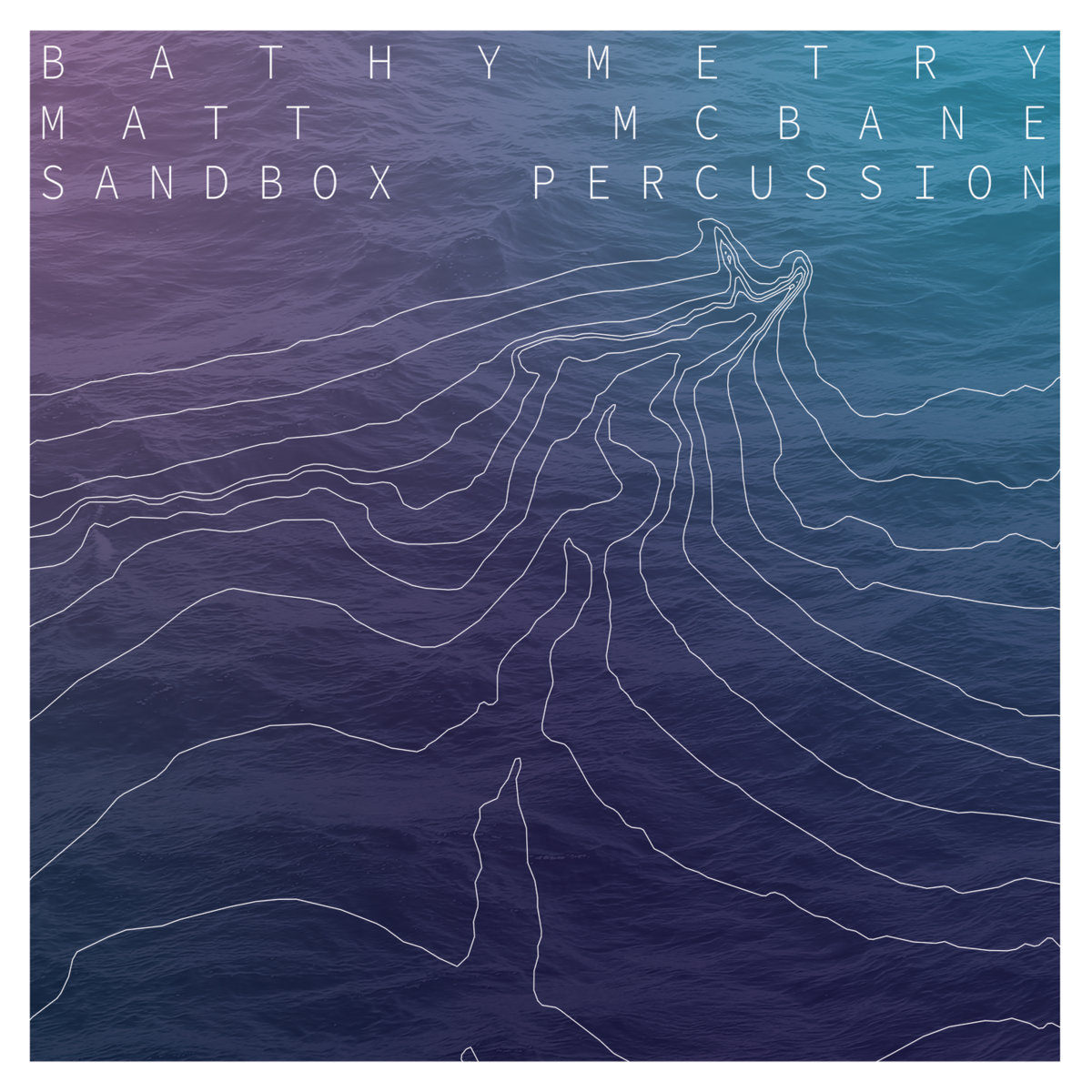 As a teenage surfer Matt McBane became obsessed with the sea and the way in which the bathymetry of the ocean floor affects the way that waves break. His composition Bathymetry mirrors that relationship, with his bass synthesizer providing the platform to shape the more trebly waves of varied percussion played by Sandbox Percussion (a well-named and playful ensemble). On the surface, this album is slightly out of my, rather idiosyncratic, comfort zone. The accompanying videos were off-putting and (politeness dictates that I cannot write what I would cheerfully do with them) ping-pong balls overused. Despite this, my listening curiosity was piqued and held steady. Then halfway through the 40 minute duration, the track "Groundswell" completely won me over, and I rode a wave of enjoyment all the way to the end. Later on, afer repeated listens, it occurred to me that the same process happens on each track, as bursts of percussive grit, pops and scrapes away, to eventually leave the rewarding pearl.
As a teenage surfer Matt McBane became obsessed with the sea and the way in which the bathymetry of the ocean floor affects the way that waves break. His composition Bathymetry mirrors that relationship, with his bass synthesizer providing the platform to shape the more trebly waves of varied percussion played by Sandbox Percussion (a well-named and playful ensemble). On the surface, this album is slightly out of my, rather idiosyncratic, comfort zone. The accompanying videos were off-putting and (politeness dictates that I cannot write what I would cheerfully do with them) ping-pong balls overused. Despite this, my listening curiosity was piqued and held steady. Then halfway through the 40 minute duration, the track "Groundswell" completely won me over, and I rode a wave of enjoyment all the way to the end. Later on, afer repeated listens, it occurred to me that the same process happens on each track, as bursts of percussive grit, pops and scrapes away, to eventually leave the rewarding pearl.
For whatever reason, I found that the second half of Bathymetry has a greater emotional and melodic impact, perhaps due to the slower pace and less cluttered soundscape. This allows the synthesizer to be more prominent and the percussion more glassy and transparent (maybe hitting bottles and bowls, or using vibraphone, instead of dropping the aforementioned balls). I have heard nurses describe conversations with certain patients as like playing table tennis with someone who rarely tries to hit the ball back and I detect a similar movement, and progression, here. As intriguing the first twenty minutes or so is, from "Groundswell" onwards it's game on. The use of a traditional drum kit there, and also on "Refraction" comes as a refreshing surprise and the effect is propulsive, as if we've been lowered slowly down into the depths of the ocean which is intriguing, but now are off and zooming around exploring in a small submarine. At several points, including "Coda", we hear what could be an underwater bell or gong; very appropriate as similar to sounds punctuating Hendrix's extended aquatic-themed pieces "1983 A Merman I Should Turn To Be" and "Moon, Turn the Tides… Gently Gently Away." The feel of Bathymetry becomes rather like improvised ambient chamber music with overtones of both dub and Harry Partch, although his percussive bowls were called cloud chamber bowls and it's possibly a breach of some critical rule to mention his name and the word "ambient" in the same sentence.
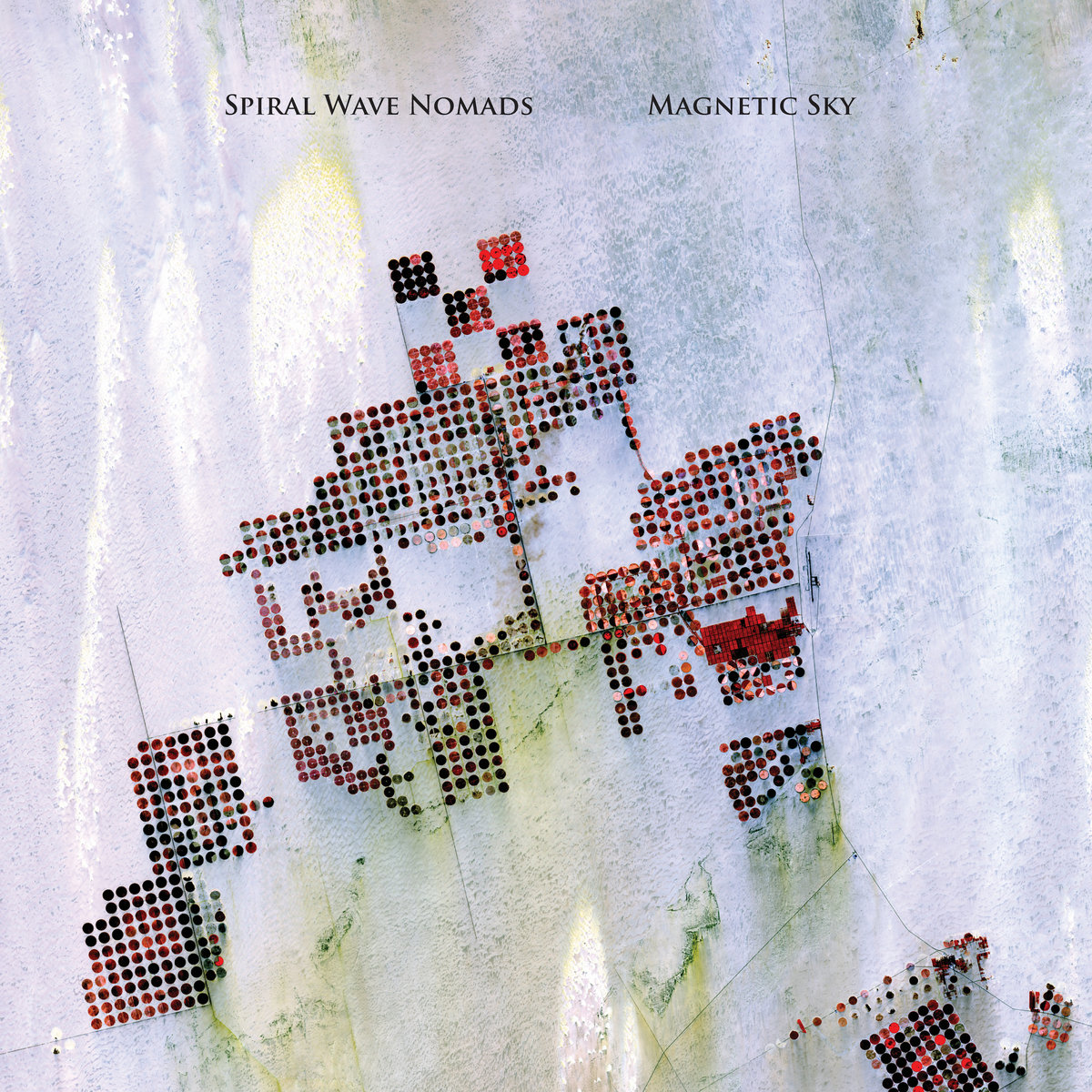 Prolific artists on their own, the duo of Eric Hardiman (guitar/bass/electronics) and Michael Kiefer (drums/keyboards) have still managed to put out their third album in four years as Spiral Wave Nomads. The spacey, psychedelic tinged guitar/bass/drum excursions are of course expected by now, but the inclusion of additional electronic instrumentation makes Magnetic Sky even greater.
Prolific artists on their own, the duo of Eric Hardiman (guitar/bass/electronics) and Michael Kiefer (drums/keyboards) have still managed to put out their third album in four years as Spiral Wave Nomads. The spacey, psychedelic tinged guitar/bass/drum excursions are of course expected by now, but the inclusion of additional electronic instrumentation makes Magnetic Sky even greater.
With six songs spread across two sides of vinyl, the duo keeps their performances somewhat succinct, given the improvisational approach. Dynamic drumming and long guitar passages tend to be the focus, but there is so much more going on in the layers beneath. Both Kiefer and Hardiman contribute electronics/synths this time around, and the watery sounds that open “Dissolving into Shape” nicely flesh out the restrained drumming and commanding lead guitar. “Under a Magnetic Sky” is also bathed in soft electronics, covering the outstretched guitar, prominent bass, and taut drumming like a warm, fuzzy blanket. “Carrier Signals” features them leaning a bit more into jazz territory, punctuated with pseudo-Eastern melodies, unconventional drumming, and sitar-like drones.
 This is the first full-length collaboration between Sabra and Tabbal, but it is apparently also the sixth collaborative release between Portland's Beacon Sound and Lebanon's Ruptured Records (which was co-founded by Tabbal). While Tabbal's solo work has been a very enjoyable recent discovery for me, this is my first encounter with Julia Sabra, who is normally one-third of the excellent Beirut-based dreampop trio Postcards. The pair do have a history of working together, as Tabbal has co-produced several Postcards releases, but their creative union only began to take shape in the aftermath of Beirut's massive 2020 port explosion (which destroyed Sabra's home, badly injured her partner/bandmate Pascal Semerdjian, and displaced a whopping 300,000 people). Unsurprisingly, one of the primary themes of Snakeskin is the precarious concept of "home" and the "the disappearance of life as we know it" in a volatile and oft-violent world. Those are admittedly more urgent themes in Tabbal and Sabra's neck of the woods than some others (the album was also inspired by the 2021 Palestinian and the invasion of Armenia), but loss and uncertainty eventually come for us all and they make a universally poignant emotional core for an album. And, of course, great art can sometimes emerge from deeply felt tragedies and Tabbal and Sabra are a match made in heaven for that challenge, as Julia's sensuous, floating vocals are the perfect complement to Tabbal's gnarled and heaving soundscapes.
This is the first full-length collaboration between Sabra and Tabbal, but it is apparently also the sixth collaborative release between Portland's Beacon Sound and Lebanon's Ruptured Records (which was co-founded by Tabbal). While Tabbal's solo work has been a very enjoyable recent discovery for me, this is my first encounter with Julia Sabra, who is normally one-third of the excellent Beirut-based dreampop trio Postcards. The pair do have a history of working together, as Tabbal has co-produced several Postcards releases, but their creative union only began to take shape in the aftermath of Beirut's massive 2020 port explosion (which destroyed Sabra's home, badly injured her partner/bandmate Pascal Semerdjian, and displaced a whopping 300,000 people). Unsurprisingly, one of the primary themes of Snakeskin is the precarious concept of "home" and the "the disappearance of life as we know it" in a volatile and oft-violent world. Those are admittedly more urgent themes in Tabbal and Sabra's neck of the woods than some others (the album was also inspired by the 2021 Palestinian and the invasion of Armenia), but loss and uncertainty eventually come for us all and they make a universally poignant emotional core for an album. And, of course, great art can sometimes emerge from deeply felt tragedies and Tabbal and Sabra are a match made in heaven for that challenge, as Julia's sensuous, floating vocals are the perfect complement to Tabbal's gnarled and heaving soundscapes.
The first piece that Sabra and Tabbal wrote together was "Roots," which surfaced last year on Ruptured's The Drone Sessions Vol. 1 compilation. That piece is reprised here as the sublimely beautiful closer, which was a great idea as it is one of the strongest songs on the album. However, it also illustrates how this collaboration has evolved and transformed, as "Roots" has the feel of a dreamy, bittersweet synth masterpiece nicely enhanced with hazy, sensuous vocals. Execution-wise, it is damn hard to top, but the duo's more recent work feels like a creative breakthrough that is greater than the sum of its parts. Put more simply, the pair previously merged their two styles in an expected way to great effect, but then they started organically blurring into a single shared style and the results turned into something more memorable and transcendent. The first major highlight is "All The Birds," which calls to mind a collision between the murky, submerged dub of loscil and what I imagine a bossa nova album by Julee Cruise might have sounded like. As cool as all that sounds, however, the reality is even better due to the muscular, snaking synth undercurrent and surprise snare-roll groove.
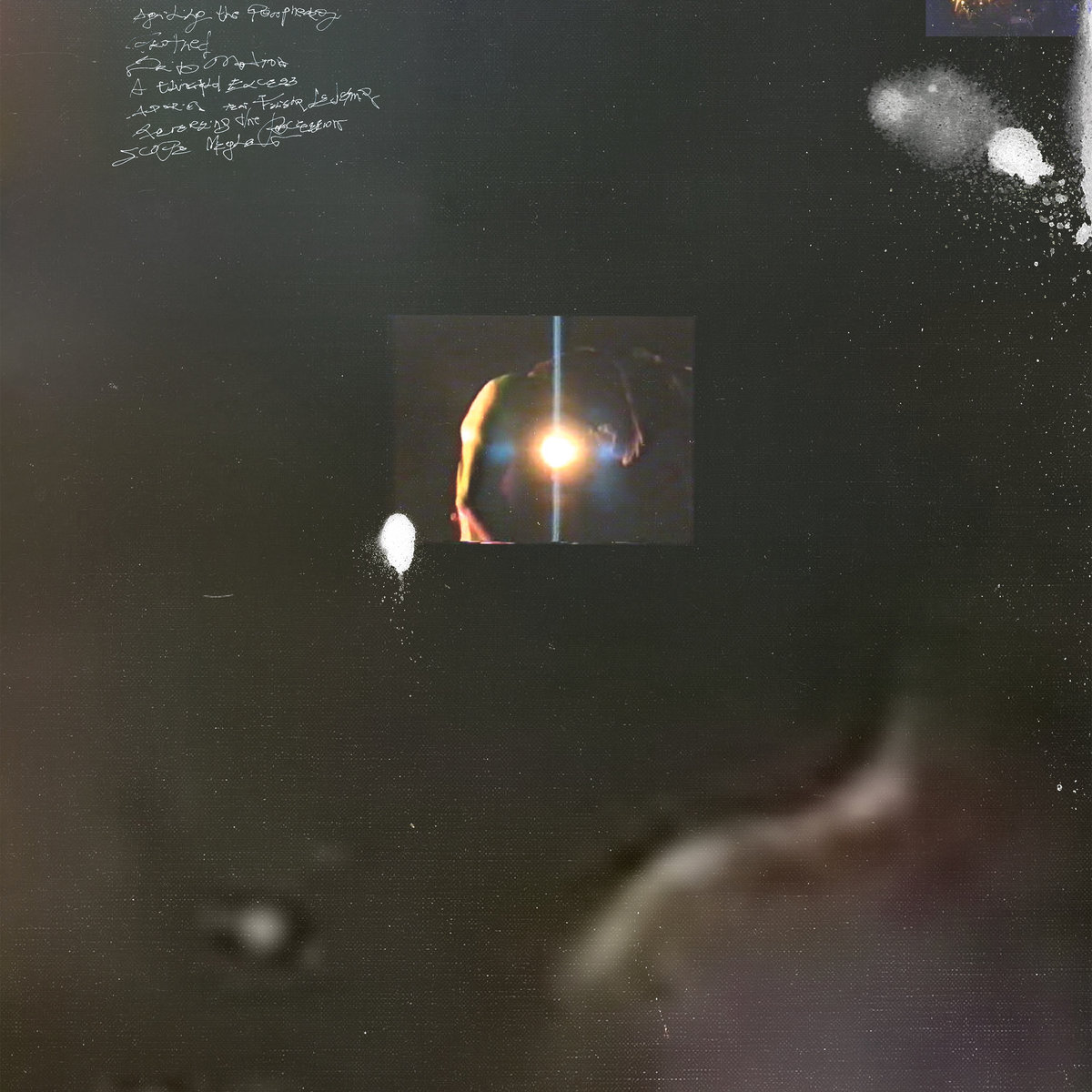 I was a bit later to the Angelo Harmsworth party than I would have liked, but the Berlin-based American composer has been fitfully releasing very distinctive blown-out "ambient" albums for about a decade now on an array of hip and discriminating small labels (Opal Tapes, Vaagner, enmossed, Psychic Liberation, etc.). Harmsworth's latest is his first for Students of Decay and marks a rare vinyl outing, as most of his previous physical releases have been limited to cassette. According to the label, Singe "may be the high water mark" of Harmsworth's career to date, which does feel like a completely plausible claim, but one that is very hard to confidently echo given how many killer Harmsworth pieces already exist. Even if Singe fails to conclusively eclipse all of Harmsworth's past triumphs, however, it does seem to be one of his most consistently strong releases and an ideal starting point for the curious. Notably, describing Harmsworth's vision as "ambient" or even "power ambient" feels cruelly reductionist, which is probably why he amusingly titled a 2020 release Fully Automated Luxury Ambient. That imaginary subgenre feels much closer to the mark, as the intensity and textural inventiveness that Angelo brings to these compositions shares far more common ground with artists like Tim Hecker or Fennesz (or collapsing power lines during a live volcano) than it does with anyone trafficking in droning, meditative loops.
I was a bit later to the Angelo Harmsworth party than I would have liked, but the Berlin-based American composer has been fitfully releasing very distinctive blown-out "ambient" albums for about a decade now on an array of hip and discriminating small labels (Opal Tapes, Vaagner, enmossed, Psychic Liberation, etc.). Harmsworth's latest is his first for Students of Decay and marks a rare vinyl outing, as most of his previous physical releases have been limited to cassette. According to the label, Singe "may be the high water mark" of Harmsworth's career to date, which does feel like a completely plausible claim, but one that is very hard to confidently echo given how many killer Harmsworth pieces already exist. Even if Singe fails to conclusively eclipse all of Harmsworth's past triumphs, however, it does seem to be one of his most consistently strong releases and an ideal starting point for the curious. Notably, describing Harmsworth's vision as "ambient" or even "power ambient" feels cruelly reductionist, which is probably why he amusingly titled a 2020 release Fully Automated Luxury Ambient. That imaginary subgenre feels much closer to the mark, as the intensity and textural inventiveness that Angelo brings to these compositions shares far more common ground with artists like Tim Hecker or Fennesz (or collapsing power lines during a live volcano) than it does with anyone trafficking in droning, meditative loops.
Those craving the aforementioned "collapsing power lines" vibe will have a mercifully short wait, as the opening "Igniting the Periphery" calls to mind buzzing high tension wires swayed by a deep seismic shudder as the surrounding buildings collapse in slow motion. There are some other elements as well, like fragments of twinkling piano and warm waves of frayed drones, but the viscerally heaving, buzzing, and gnarled wreckage at the heart of the piece is the showstopper—everything else is just there to color the mood. That balance holds true for the rest of the album as well, as the Singe experience feels akin to wandering through six cataclysmic yet weirdly beautiful natural disasters. For example, the crackling and hissing "Frothed" evokes slow jets of magma breaking through a buckling, blasted landscape, while "Drip Motion" has the feel of a storm slowly forming and then slowly dissipating. In short, Harmsworth harnesses the proverbial "force of nature" and wields it beautifully. That said, "Drip Motion" is an album highlight for more conventionally musical reasons as well, as it resembles the burning and heaving wreckage of a killer Porter Ricks cut fading in and out of focus. "A Twofold Excess" then ends the album's first half with yet another gem, as it feels like slowed-down footage of a tornado ripping apart a sawmill before dissolving into a sublime coda of sputtering static, tender piano, and warbling, whimpering streaks of psychedelia.
 Dave Clarkson is a gem who has flown under my—far from infallible—radar for about 30 years. There are upwards of 40 releases emanating in his impressive catalog, from the Cavendish House studio, including many of these Guides which have focused on everything from beaches, caves, forests, and lighthouses, with tangents to rain, ghost stories and illness. That another of his albums, For Horselover Fat by Eye In The Sky has a bash at honoring the concerns and creativity of the astonishing Philip K. Dick is right up my alley.
Dave Clarkson is a gem who has flown under my—far from infallible—radar for about 30 years. There are upwards of 40 releases emanating in his impressive catalog, from the Cavendish House studio, including many of these Guides which have focused on everything from beaches, caves, forests, and lighthouses, with tangents to rain, ghost stories and illness. That another of his albums, For Horselover Fat by Eye In The Sky has a bash at honoring the concerns and creativity of the astonishing Philip K. Dick is right up my alley.
I love everything about A Pocket Guide To Dreamland: the concept and how it sounds of course, but equally the perfect anorak-fetishistic packaging of the physical release with badges, a transparent orange cassette, postcards, and its cover label paying homage to Ordnance Survey maps above images depicting the almost psychedelic childlike thrill of a seaside funfair along with a gritty high rise apartment block tower. I almost expected some recreated cut-out coupons from The Eagle * comic for a day at Butlins Holiday Camp (Admit Family of 4 to unglamorous Skegness location).
 As John Jagos sings "Save me from the grip of the modern age" early on in "Tangerine," the opening track of the latest from his alter-ego Brothertiger, three words spring to mind: sparkling, honest, and nostalgic. Indeed, the music hearkens back to the ilk of carefully crafted new wave sounds in the vein of ABC and Spandau Ballet, minus any flamboyance and serving up no pretentiousness. What remains is perfectly composed chill electronic pop, melody at the forefront. With sounds like summer wafting wistfully through headphones as I write, this is music perfect for road trips in the middle of nowhere, lounging on a beach recliner while the waves roll in, or simply snuggling under a blanket with the music present like a good friend.
As John Jagos sings "Save me from the grip of the modern age" early on in "Tangerine," the opening track of the latest from his alter-ego Brothertiger, three words spring to mind: sparkling, honest, and nostalgic. Indeed, the music hearkens back to the ilk of carefully crafted new wave sounds in the vein of ABC and Spandau Ballet, minus any flamboyance and serving up no pretentiousness. What remains is perfectly composed chill electronic pop, melody at the forefront. With sounds like summer wafting wistfully through headphones as I write, this is music perfect for road trips in the middle of nowhere, lounging on a beach recliner while the waves roll in, or simply snuggling under a blanket with the music present like a good friend.
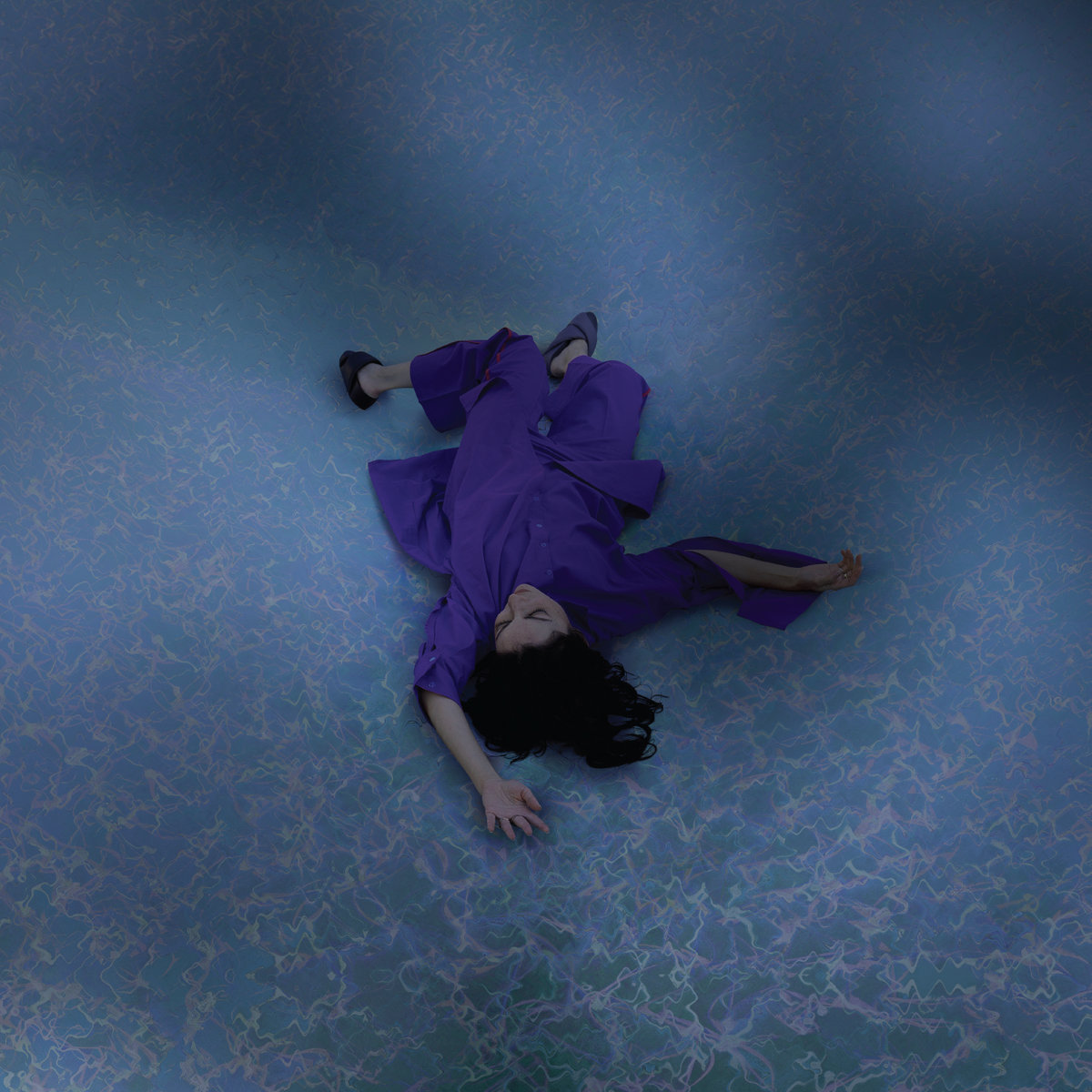 I was caught completely off guard by this latest opus from Dalt, as much of it sounds more like a three-way collaboration between Astrud Gilberto, Perez Prado, and Walter Wanderley than anything resembling the warped and stark electronic pop mutations that the Colombian composer has become synonymous with. After my initial disbelief subsided, however, I quickly decided that ¡Ay! may very well be the strongest album of Dalt's career to date. I suspect Dalt herself would probably agree, as it would be fair to say that her vision remains as compelling and innovative as ever, but she has merely kicked her self-imposed artistic restraints to the curb and embraced the warmer, more sensuous, and melodic sounds that she grew up around. Or, as the album description colorfully puts it, "through the spiraling tendencies of time and topography, Lucrecia has arrived where she began." In any case, the end result is a wonderfully sultry and evocative collection of seductive vocals and tropical rhythms beautifully enhanced with a host of psychotropic and industrial-damaged touches. And she somehow makes it sound like the most natural thing in the world. I definitely did not expect Dalt to secretly be a tropical pop genius at all, which makes her previous albums all the more fascinating now that I know that they were made while pointedly suppressing some of her greatest strengths.
I was caught completely off guard by this latest opus from Dalt, as much of it sounds more like a three-way collaboration between Astrud Gilberto, Perez Prado, and Walter Wanderley than anything resembling the warped and stark electronic pop mutations that the Colombian composer has become synonymous with. After my initial disbelief subsided, however, I quickly decided that ¡Ay! may very well be the strongest album of Dalt's career to date. I suspect Dalt herself would probably agree, as it would be fair to say that her vision remains as compelling and innovative as ever, but she has merely kicked her self-imposed artistic restraints to the curb and embraced the warmer, more sensuous, and melodic sounds that she grew up around. Or, as the album description colorfully puts it, "through the spiraling tendencies of time and topography, Lucrecia has arrived where she began." In any case, the end result is a wonderfully sultry and evocative collection of seductive vocals and tropical rhythms beautifully enhanced with a host of psychotropic and industrial-damaged touches. And she somehow makes it sound like the most natural thing in the world. I definitely did not expect Dalt to secretly be a tropical pop genius at all, which makes her previous albums all the more fascinating now that I know that they were made while pointedly suppressing some of her greatest strengths.
RVNG Intl.
The opening "No Tiempo" initially evokes a "late-night cable" fever dream vibe in which a Bela Lugosi vampire movie blurs into an organ-happy televangelist, but it quickly transforms into swaying tropical bliss once the flutes and the lazily sultry groove make the scene. It has the feel of a Wanderley/Gilberto collaboration that has been punched up (and sexed up) for contemporary ears by an intrepid DJ (though I was still startled by the brass finale). It is a great piece, but it is immediately eclipsed by the following "El Galatzó," which masterfully combines hushed, confessional-sounding vocals with bass strums, trilling flutes, cooing backing vox, swelling strings, industrial scrapes, strangled feedback, and killer hand-percussion to cast a sustained spell of noir-ish, cinematic seduction. While "El Galatzó" would be my personal pick for the album's reigning highlight, the album is not hurting for other hot contenders for that honor. In "Contenida," for example, a hallucinatory fog and a jazzy double bass motif cohere into some kind of humid and dubby bossa nova mindfuck, which then beautifully erupts in a viscerally clattering metal percussion frenzy. If the whole album sustained a similarly perfect balance of ambitious dub/industrial production brilliance and sultry songcraft, I would have no hesitation at all about proclaiming ¡Ay! to be the album of the year.
 This is Mikko Singh's best and most consistent record yet as Haleiwa. Both his first full length releases Pura Vida dude and Palm Trees Of The Subarctic were light and dreamy, while his third Cloud Formations accelerated Haleiwa onto another level, driven by good tunes and several great moments, not least the plunge through synthesizers into warm bass driven melody on the opener "HKI-97," and the digital blips of "Foggy" which (perhaps unconsciously) resembles Brian Wilson frantically transposing part of "California Girls" into morse code. That third record heralded a deeper sound, perhaps because Singh switched to analog cassette and reel-to-reel tape recording, and it also included more variety although for no clear reason. Hallway Waverider avoids that pitfall by finding a sweet spot and then showing little or no desire to move very far away.
This is Mikko Singh's best and most consistent record yet as Haleiwa. Both his first full length releases Pura Vida dude and Palm Trees Of The Subarctic were light and dreamy, while his third Cloud Formations accelerated Haleiwa onto another level, driven by good tunes and several great moments, not least the plunge through synthesizers into warm bass driven melody on the opener "HKI-97," and the digital blips of "Foggy" which (perhaps unconsciously) resembles Brian Wilson frantically transposing part of "California Girls" into morse code. That third record heralded a deeper sound, perhaps because Singh switched to analog cassette and reel-to-reel tape recording, and it also included more variety although for no clear reason. Hallway Waverider avoids that pitfall by finding a sweet spot and then showing little or no desire to move very far away.
Of course there is variety here, but it is subsumed beneath a definite creative vision; a vision which looks backwards. Dedicated to his mother who passed away in 2015, and inspired by his own earlier self spending winter months skateboarding in his bedroom while listening to music. The overall sound is of music for surfing, but surfing on air, memory, and metaphor, back to the halcyon days of carefreeness and family love. If there is any slight hint of original Dick Dale surf guitar twang (or even Psychocandy style surfing on polluted Glaswegian effluent) it has died peacefully and gone to heaven in a sonic envelope of featherlight fuzz.
 This may be Swiss pianist/composer Raphael Loher's first solo album, but he has crossed my path before with his Baumschule trio (featuring Julian Sartorius and Manuel Troller). I am much less familiar with Loher's other trio (KALI), but the importance is that he has spent time improvising with inspiring musicians and has accumulated some very intriguing compositional ideas along the way. Interestingly, Keemuun is itself a bit of an improvisatory collaboration with inspiring (if unwitting) musicians, as Loher often played along with albums by other artists while experimenting with his rapid-fire piano patterns (Beatrice Dillon's rhythmically adventurous Workaround was a particularly central touchstone). In fact, just about everything about this album's evolution feels like fertile grist for a "galaxy brain" meme: a prepared piano album…limited to only ten notes spanning two octaves…improvised against cutting edge techno rhythms…but with all of those foundational rhythms totally excised from the final recording. Needless to say, all of those factors make for a very cool album concept in theory, but I am pleased to report that Loher's brilliant execution has made this a killer album in reality as well.
This may be Swiss pianist/composer Raphael Loher's first solo album, but he has crossed my path before with his Baumschule trio (featuring Julian Sartorius and Manuel Troller). I am much less familiar with Loher's other trio (KALI), but the importance is that he has spent time improvising with inspiring musicians and has accumulated some very intriguing compositional ideas along the way. Interestingly, Keemuun is itself a bit of an improvisatory collaboration with inspiring (if unwitting) musicians, as Loher often played along with albums by other artists while experimenting with his rapid-fire piano patterns (Beatrice Dillon's rhythmically adventurous Workaround was a particularly central touchstone). In fact, just about everything about this album's evolution feels like fertile grist for a "galaxy brain" meme: a prepared piano album…limited to only ten notes spanning two octaves…improvised against cutting edge techno rhythms…but with all of those foundational rhythms totally excised from the final recording. Needless to say, all of those factors make for a very cool album concept in theory, but I am pleased to report that Loher's brilliant execution has made this a killer album in reality as well.
The album consists of four numbered pieces, the first of which is considerably more subdued and minimal than the others (and shorter too). To my ears, the opener lies somewhere between bleary Morton Feldman-style dissonance and a dying, slightly out-of-tune music box performing its own elegy. It makes a perfectly fine (if understated) introduction, but I doubt I would be writing about Keemuun if it did not catch fire with the second piece and sustain that white-hot level of inspiration for the remainder of the album.
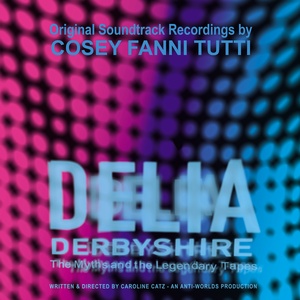 We seem to be in the midst of a long-overdue Delia Derbyshire renaissance at the moment due to the efforts of filmmaker Caroline Catz, Cosey Fanni Tutti, BBC Radiophonic Workshop's Mark Ayres, and others. Fittingly, this unusual and inspired album was commissioned back in 2018 as a score for Catz's similarly unconventional feature-length documentary. Sadly, it seems damn near impossible to see Catz's film at the moment (outside the UK, at least), but this soundtrack was released earlier this year to coincide with Cosey's own foray into telling Derbyshire's story (Re-Sisters: The Lives and Recordings of Delia Derbyshire, Margery Kempe and Cosey Fanni Tutti). The book, film, and album were all inspired by research into Derbyshire's archive and the voluminous recordings and writings that became available after the visionary electronic artist's passing in 2001. Apparently, copyright issues are preventing much of Derbyshire's unearthed work from seeing an official release (there are some great unofficial ones like Inventions For Radio/The Dreams out there), but this album is a compelling consolation prize: using Derbyshire's notes on her compositions and techniques, Cosey has achieved a sort of posthumous homage/collaboration in which her own aesthetic is co-mingled with Derbyshire's singular and groundbreaking techniques and sounds.
We seem to be in the midst of a long-overdue Delia Derbyshire renaissance at the moment due to the efforts of filmmaker Caroline Catz, Cosey Fanni Tutti, BBC Radiophonic Workshop's Mark Ayres, and others. Fittingly, this unusual and inspired album was commissioned back in 2018 as a score for Catz's similarly unconventional feature-length documentary. Sadly, it seems damn near impossible to see Catz's film at the moment (outside the UK, at least), but this soundtrack was released earlier this year to coincide with Cosey's own foray into telling Derbyshire's story (Re-Sisters: The Lives and Recordings of Delia Derbyshire, Margery Kempe and Cosey Fanni Tutti). The book, film, and album were all inspired by research into Derbyshire's archive and the voluminous recordings and writings that became available after the visionary electronic artist's passing in 2001. Apparently, copyright issues are preventing much of Derbyshire's unearthed work from seeing an official release (there are some great unofficial ones like Inventions For Radio/The Dreams out there), but this album is a compelling consolation prize: using Derbyshire's notes on her compositions and techniques, Cosey has achieved a sort of posthumous homage/collaboration in which her own aesthetic is co-mingled with Derbyshire's singular and groundbreaking techniques and sounds.
While Delia Derbyshire is far from a household name, it is something of a miracle that she ever managed to be revered at all, as her musical career only spanned 15 years and took place at a time when neither women nor electronic music were taken particularly seriously. On top of that, she also had an eccentric personality, a tendency towards alcoholism, and an employer (the BBC) who did not consider her work to be "music" enough for her to be credited as a composer. Fortunately, she was both motivated and fucking brilliant, so she still managed to make a profound impact on the evolution of music despite those incredibly long odds. And it did not hurt that she was responsible for the Doctor Who theme, which made a sizable cultural dent of its own. It is hard to say whether or not there would have been a Throbbing Gristle had Derbyshire and her Radiophonic Workshop colleagues not forced weird electronic music into the mainstream, but I do think Derbyshire might have traumatized the general populace to a Gristle-y degree in the early '60s if her gear had been more portable. Obviously, bloody-minded persistence in the face of disrespect and hostility is a relatable theme for Cosey as well, so it is hard to think of another artist who could be more naturally suited for a project such as this. In short, Catz needed appropriately "Derbyshire" music for her film, but there were very few usable Derbyshire recordings available. Introduce Cosey Fanni Tutti, who immersed herself in the archive's collection (267 reel-to-reel tapes found in cereal boxes, I believe) and Derbyshire's notes and set about casting a Delia-esque spell in her own way on her own gear (though Delia's actual voice does make some appearances). As an aside, this is not Cosey's first homage to Derbyshire, as Carter Tutti's "Coolicon" took its name and inspiration from a metal lampshade that Delia regularly used to make sounds.
 When I first heard the thumping house/disco EP Was It Ever Real?, I had a very hard time believing that it could possibly be a teaser for something more substantial, as much of that EP felt like top-tier Soft Pink Truth that leaves very little room for improvement. If those songs did not make the cut for the full-length, I felt the album surely had to be either absolutely brilliant or absolutely wrong-headed with no possible middle ground. As it turns out, I was at least right about the "little room for improvement" bit, as Is It Going To Get Any Deeper Than This? is not noticeably stronger than the preceding EP. Instead, it feels more like a lateral move, taking Drew Daniel's star-studded house party in a more kaleidoscopically arty and eccentric direction. Unsurprisingly, Deeper features roughly the same international cast of talented guests as the EP, but there are some noteworthy new additions as well, such as Nate Wooley, Wye Oak's Jenn Wasner, and Jaime Stewart (Xiu Xiu). The result is a bit less "all killer, no filler" this time around, but the trade-off is that Deeper is an appropriately deeper and more immersive plunge into Daniel's psyche, touching upon everything from Barry White to George Bataille to krautrock while still managing to be functional, forward-thinking, and archly fun dance music.
When I first heard the thumping house/disco EP Was It Ever Real?, I had a very hard time believing that it could possibly be a teaser for something more substantial, as much of that EP felt like top-tier Soft Pink Truth that leaves very little room for improvement. If those songs did not make the cut for the full-length, I felt the album surely had to be either absolutely brilliant or absolutely wrong-headed with no possible middle ground. As it turns out, I was at least right about the "little room for improvement" bit, as Is It Going To Get Any Deeper Than This? is not noticeably stronger than the preceding EP. Instead, it feels more like a lateral move, taking Drew Daniel's star-studded house party in a more kaleidoscopically arty and eccentric direction. Unsurprisingly, Deeper features roughly the same international cast of talented guests as the EP, but there are some noteworthy new additions as well, such as Nate Wooley, Wye Oak's Jenn Wasner, and Jaime Stewart (Xiu Xiu). The result is a bit less "all killer, no filler" this time around, but the trade-off is that Deeper is an appropriately deeper and more immersive plunge into Daniel's psyche, touching upon everything from Barry White to George Bataille to krautrock while still managing to be functional, forward-thinking, and archly fun dance music.
The album kicks off in style with its first certified banger, "Deeper," which deceptively fades in with bleary drones before launching into a straight up classic disco groove with all the requisite hand claps and funky guitars. There is enough subtle dissonance to give it a somewhat delirious and unreal feeling right from the jump, but things do not get truly art-damaged until an unexpected church bell passage subsides. While the groove remains unswervingly propulsive for a bit longer, the insistent sexy thump is increasingly mingled with generous helpings of kitschy string stabs, tropical-sounding guitars, hazy flutes, and a host of other inspired psych touches before it all dissolves into smeary abstraction. I suppose the extended running time and ambient comedown preclude "Deeper" from being a hot single, but several of the pieces that immediately follow gamely rekindle the dancefloor fire. "La Joie Devant La Mort" is one of the album's more "perverse pop moments," as Jaime Stewart sings a George Bataille line about being in search of joy before death over an endearingly weird groove that calls to mind Coil's Love's Secret Domain album colliding with "A Fifth of Beethoven" and a chorus of tiny frogs. Wasner then takes the mic for the breezily sensuous "Wanna Know," which milks the album title's question for all its worth over a groove that could have been plucked from a Love Unlimited Orchestra album. The following "Trocadero" then pays homage to the "sleaze" disco subgenre synonymous with the titular SF club before "Mood Swing" ends the first half with a killer slow-building disco fusion of spiritual jazz, gurgling psychedelia, and Reich-ian piano patterns.
On two distinct new albums, legendary composer Asmus Tietchens approaches different subject material with his current technique of recycling sounds beyond the point of any recognition. Schatten Ohne Licht (Shadow Without Light) is grounded in post-anthropological concepts influenced by scholar/writer Ulrich Horstmann's conceptualization of a planet devoid of biological life. Comparatively, Parallelen would seem focused on more theoretical mathematics and a greater sense of the abstract.
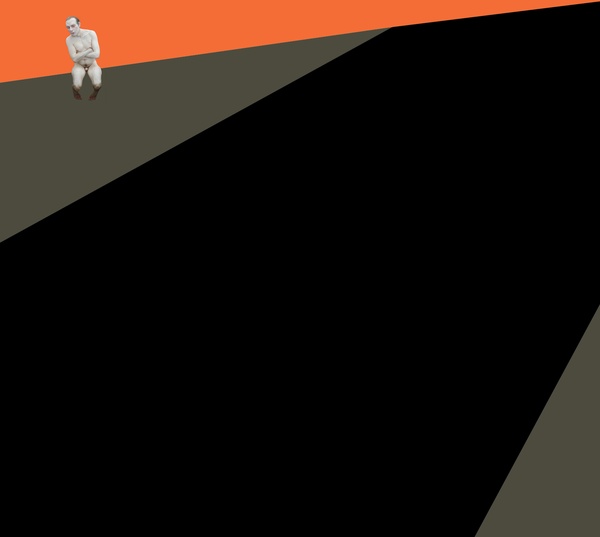 The opening title piece of Schatten Ohne Licht features Tietchens blending quiet tones with distant, low-end rumbles, with both the higher and lower frequencies layering and building throughout. Towards the half-way point he switches things around, using the same components but swapping around the arrangements, becoming a different sounding piece entirely. "Anthroporsaurus" follows a similar approach, pairing floating hints of melody with deep space pulsations and a machinery like chug, although the sum total of the parts is more delicate than anything else.
The opening title piece of Schatten Ohne Licht features Tietchens blending quiet tones with distant, low-end rumbles, with both the higher and lower frequencies layering and building throughout. Towards the half-way point he switches things around, using the same components but swapping around the arrangements, becoming a different sounding piece entirely. "Anthroporsaurus" follows a similar approach, pairing floating hints of melody with deep space pulsations and a machinery like chug, although the sum total of the parts is more delicate than anything else.
Later, "Es ist Endlich Still" (It's Finally Quiet) is a perfect example of the post-organic life themes of the album. High register crystalline sounds are joined with liquid, wet noise. Combining strange outbursts, flattened frequencies, and some occasional crackling, it sounds as empty and devoid of life as the title would insinuate. Closer "Kolosse" is an appropriately dramatic ending, all shimmering and looming space with chiming swells peppered throughout. As a whole it is more forceful and heavy compared to the other pieces on the disc, and results in a fitting climax for the album.

 On their second album this trio continues the sound of their 2018's self-titled debut, expanding the dense, continually flowing sound showcased there even further. Across three instrumentals (and one shorter vocal based song), More Klementines effortlessly jump between expansive improvised passages with taut, motorik rhythmic sections, resulting in a perfect junction of two very different styles.
On their second album this trio continues the sound of their 2018's self-titled debut, expanding the dense, continually flowing sound showcased there even further. Across three instrumentals (and one shorter vocal based song), More Klementines effortlessly jump between expansive improvised passages with taut, motorik rhythmic sections, resulting in a perfect junction of two very different styles.
Dynamic shifts are something More Klementines accomplishes effortlessly. Right from the opening of "Hot Peace," Michael Kiefer propels the lengthy session with subtle, understated drumming and delicate chimes, while guitarist Jon Schlesinger and multiple instrumentalist Steubs weave in layered guitar and bass. Occasionally drifting towards jam band territory (but keeping things tastefully psychedelic and dissonant), the trio drift into an expansive, open passage about two thirds of the way through, eventually building back to a wall of guitar scrapes and scatter-shot drumming.
 This is my first encounter with this UK-based improv unit, but Fallout 4 is the latest installment of a series of live documents that began all the way back in 2001. The band/collective itself has existed since 1996, though it seems like there's been at least one decade-long hiatus and the ensemble's members have all been active in other projects ranging from prog to ambient to art pop (while Andrew Ostler has been busy building modular synth hardware, among other things). Notably, Darkroom has recently reactivated and released some new material, but the performance documented here dates back to 2012 and the aesthetic lies somewhere between slow-burning Tarentel-style post-rock and Tangerine Dream-inspired space ambient (though Can was apparently a significant inspiration as well). On a related note, the album was mastered by Jono Podmore, who played a significant role in yet another fine vault project (Can's The Lost Tapes). I suspect Podmore had a challenging task on his hands, as the band tellingly state that he was chosen both for "his ability to control sonic forces" and "to make sure it was finally done." While this album and the Fallout series in general capture the band in a more noirish and shadowy mood than usual, I can see why they were so keen to get these recordings out into the world even a decade late, as much of this album is spacey, slow-motion psych magic.
This is my first encounter with this UK-based improv unit, but Fallout 4 is the latest installment of a series of live documents that began all the way back in 2001. The band/collective itself has existed since 1996, though it seems like there's been at least one decade-long hiatus and the ensemble's members have all been active in other projects ranging from prog to ambient to art pop (while Andrew Ostler has been busy building modular synth hardware, among other things). Notably, Darkroom has recently reactivated and released some new material, but the performance documented here dates back to 2012 and the aesthetic lies somewhere between slow-burning Tarentel-style post-rock and Tangerine Dream-inspired space ambient (though Can was apparently a significant inspiration as well). On a related note, the album was mastered by Jono Podmore, who played a significant role in yet another fine vault project (Can's The Lost Tapes). I suspect Podmore had a challenging task on his hands, as the band tellingly state that he was chosen both for "his ability to control sonic forces" and "to make sure it was finally done." While this album and the Fallout series in general capture the band in a more noirish and shadowy mood than usual, I can see why they were so keen to get these recordings out into the world even a decade late, as much of this album is spacey, slow-motion psych magic.
Expert Sleepers
At the time of the recording, Darkroom were pared down to just the core duo of Michael Bearpark (guitars) and Andrew Ostler (synths) and two of the album's three pieces are taken from the final date of the pair's 2012 tour. Amusingly, Bearpark and Ostler note that some of that performance happened "even after most of the audience had left," as they found themselves in an unusually inspired mood that night and were in no hurry to stop playing. The album's third piece is culled from other recordings from the tour, though it is not specified whether "Tuesday's Ghost" is from a different gig or a rehearsal tape. Regardless of where and when it was recorded, "Tuesday's Ghost" is one hell of a killer piece. It slowly fades into existence with hazy synth drones and a languorous bass pulse, which is a very common theme for the album, but the beauty lies in how the duo organically transform that gently spacey ambient into a hypnotic, immersive, and shoegaze-damaged epic. Each of album's three pieces gets to that place eventually, but "Tuesday's Ghost" captures the pair in especially fine form, transcending their usual fare with inspired touches like a warbling, supernatural-sounding loop; a quavering feedback howl; and a simmering, charmingly Latin-influenced beat (once it all properly catches fire, at least).
 This Chicago-based singer-songwriter is a bit of an enigma to me, as details about his discography are quite slim. As far as I can tell, however, 3am is his second solo album, which is noteworthy given that it has been 8 long years since Swan’s similarly excellent debut (I'll Be Around) surfaced. What he was up to during that hiatus is mostly unknown to me (aside from "drawing the night in around his private, unnerving vigil," of course), but one thing I do know is that he formed a duo with James Schimpl called Dead Bandit that released their debut on Quindi last year (the same label behind this album). In any case, 3am is one hell of an aptly titled album, as it very much has the feel of a hushed, late-night confessional via four-track. The overall aesthetic calls to mind the "desolate outsider folk" blurring of an insomniac Elliott Smith or Zelienople with the homespun intimacy of early Iron and Wine, yet the pervasive mood of late night sadness is beautifully balanced with cool production tricks and shades of more lively and eclectic influences like Suicide and Charlie Megira.
This Chicago-based singer-songwriter is a bit of an enigma to me, as details about his discography are quite slim. As far as I can tell, however, 3am is his second solo album, which is noteworthy given that it has been 8 long years since Swan’s similarly excellent debut (I'll Be Around) surfaced. What he was up to during that hiatus is mostly unknown to me (aside from "drawing the night in around his private, unnerving vigil," of course), but one thing I do know is that he formed a duo with James Schimpl called Dead Bandit that released their debut on Quindi last year (the same label behind this album). In any case, 3am is one hell of an aptly titled album, as it very much has the feel of a hushed, late-night confessional via four-track. The overall aesthetic calls to mind the "desolate outsider folk" blurring of an insomniac Elliott Smith or Zelienople with the homespun intimacy of early Iron and Wine, yet the pervasive mood of late night sadness is beautifully balanced with cool production tricks and shades of more lively and eclectic influences like Suicide and Charlie Megira.
The album’s description insightfully notes that Swan’s aesthetic plays “on the natural distortion and delirium which occurs at the farthest end of the night,” which is an excellent way to explain how this album differs dramatically from ostensibly similar artists exploring the “after late night television pain” vein such as Russian Tsarlag or Matt Christensen. Swan has some darkness to exorcise, to be sure (check out “Hospice”), but 3am feels more like a batch of poignant and hook-filled gems that were handed off to the night itself for a “late night delirium” production overhaul. Obviously, that is not what actually happened, which makes Swan a bit of a visionary production-wise: he uses the same roughly instrumentation as everyone else, but those instruments are inevitably veiled in hiss, buried deep in the mix, or distorted by their lo-fi recording process (Swan apparently “drags the music through layer upon layer of tape fuzz” as part of his process). Significantly, he goes the opposite route with his vocals, as they sound close mic’d in a way where it feels like Swan is whispering directly into my ear. Rather than hiding himself in a fog of reverb and hiss, he expertly wields murk to weave a haunted and hallucinatory backdrop for his stark, emotionally direct songs. The album’s lead single “Puppeteers Tears” is an especially fine illustration of Swan’s inspired strain of ghostly Americana, as it feels like something from The Creek Drank the Cradle eerily enhanced with a haunting whistle loop, a buried organ motif, and a primitive drum machine groove.
 Keeping up with Andrew Chalk’s discography has always been an amusingly challenging endeavor, but the challenge has shifted from pouncing on limited edition physical releases to vigilantly ensuring that he does not quietly surface with a substantial new opus of some kind without my notice. The most recent substantial new opus is this one on Colin Potter’s ICR label, which is billed as Chalk’s “first new solo album in five years.” It certainly feels like a major statement to me, though the meaning of terms like “new” and “album” can be quite blurry and elusive given Chalk’s singularly minimalist approach to providing album details. In any case, The End Times was (perhaps prophetically) recorded earlier this year and marks a rare CD release after Chalk’s recent run of cassettes. Beyond that, further details are quite slim. That is just fine by me, as the only thing that actually matters is that Andrew Chalk is still making incredibly beautiful and distinctive music, as The End Times is a characteristically sublime and immersive dreamscape of tender melodies, elegantly shifting moods, and vividly detailed textures.
Keeping up with Andrew Chalk’s discography has always been an amusingly challenging endeavor, but the challenge has shifted from pouncing on limited edition physical releases to vigilantly ensuring that he does not quietly surface with a substantial new opus of some kind without my notice. The most recent substantial new opus is this one on Colin Potter’s ICR label, which is billed as Chalk’s “first new solo album in five years.” It certainly feels like a major statement to me, though the meaning of terms like “new” and “album” can be quite blurry and elusive given Chalk’s singularly minimalist approach to providing album details. In any case, The End Times was (perhaps prophetically) recorded earlier this year and marks a rare CD release after Chalk’s recent run of cassettes. Beyond that, further details are quite slim. That is just fine by me, as the only thing that actually matters is that Andrew Chalk is still making incredibly beautiful and distinctive music, as The End Times is a characteristically sublime and immersive dreamscape of tender melodies, elegantly shifting moods, and vividly detailed textures.
The opening “House of the Holy” provides an appropriately representative introduction to the album’s overall aesthetic, as a vaporous melody of blurred, lingering notes unfolds over a gently gurgling pulse. As the album unfolds, a few subtle new details emerge that set The End Times apart from some of Chalk’s other recent work, but the most prominent features throughout are the quivering, liquid-like character of the notes and the ephemeral brevity of the pieces. Rather than evolving and expanding, these 13 pieces instead feel like a series of enigmatic mirages that offer a fleeting and flickering glimpse of heaven before dissolving back into nothingness. Given all the gentle, blurred sounds and the tone of meditative reverie, it is deceptively easy to mistake The End Times for ambient music, yet it reveals itself to be considerably more than that for those willing to fully immerse themselves in Chalk’s slow-motion fantasia of beautiful details and small yet significant events. I view it as somewhat akin to looking through a rain-streaked window–it is easy to gaze through the glass and simply think “today is a wet and overcast day,” but it is also possible to appreciate how the individual droplets quiver and roll down the glass or how the streaks of water subtly bend and warp the appearance of the outside world. Albums like this are the reason why the genre term “lowercase” needed to exist, as Chalk’s compositions are incredibly rich, but the size of the reward is directly proportional to how closely one listens.



